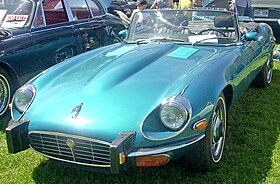Jaguar XKE
| Jaguar E-Type | |
|---|---|

The first production open two-seater
a 1961 E-Type Series 1 3.8-Litre roadster |
|
| Overview | |
| Manufacturer | Jaguar Cars |
| Also called | Jaguar XK-E |
| Production | 1961–75 |
| Assembly | Coventry, England |
| Designer | Malcolm Sayer |
| Body and chassis | |
| Class | Sports car |
| Layout | FMR layout |
| Related |
Jaguar D-Type Jaguar XJ13 |
| Chronology | |
| Predecessor | Jaguar XK150 |
| Successor | Jaguar XJ-S |
| Series 1 | |
|---|---|
 |
|
| Overview | |
| Production | March 1961–68 |
| Body and chassis | |
| Body style | 2-door fastback coupe 2-door 2+2 fastback coupe 2-door roadster |
| Powertrain | |
| Engine | 3.8 L XK I6 4.2 L XK I6 |
| Transmission | 4-speed manual; 3-speed automatic (automatic available 1966-onward, 2+2 model only) |
| Dimensions | |
| Wheelbase | 96.0 in (2,438 mm) (FHC / OTS) 105.0 in (2,667 mm) (2+2) |
| Length | 175.3125 in (4,453 mm) (FHC / OTS) 184.4375 in (4,685 mm) (2+2) |
| Width | 65.25 in (1,657 mm) (all) |
| Height | 48.125 in (1,222 mm) (FHC) 50.125 in (1,273 mm) (2+2) 46.5 in (1,181 mm) (OTS) |
| Kerb weight | 2,900 lb (1,315 kg) (FHC) 2,770 lb (1,256 kg) (OTS) 3,090 lb (1,402 kg) (2+2) |
| Series 2 | |
|---|---|
 |
|
| Overview | |
| Production | 1968–71 |
| Body and chassis | |
| Body style | 2-door fastback coupe 2-door 2+2 fastback coupe 2-door roadster |
| Powertrain | |
| Engine | 4.2 L XK I6 |
| Dimensions | |
| Kerb weight | 3,018 lb (1,369 kg) (FHC) 2,750 lb (1,247 kg) (OTS) 3,090 lb (1,402 kg) (2+2) |
| Series 3 | |
|---|---|

Jaguar E-Type Series 3 roadster
|
|
| Overview | |
| Production | 1971–75 |
| Body and chassis | |
| Body style | 2-door 2+2 coupe 2-door roadster |
| Powertrain | |
| Engine | 5.3 L Jaguar V12 engine |
| Dimensions | |
| Wheelbase | 105 in (2,667 mm) (both) |
| Length | 184.4 in (4,684 mm) (2+2) 184.5 in (4,686 mm) (OTS) |
| Width | 66.0 in (1,676 mm) (2+2) 66.1 in (1,679 mm) (OTS) |
| Height | 48.9 in (1,242 mm) (2+2) 48.1 in (1,222 mm) (OTS) |
| Kerb weight | 3,361 lb (1,525 kg) (2+2) 3,380 lb (1,533 kg) (OTS) |
The Jaguar E-Type, or the Jaguar XK-E for the North American market, is a British sports car that was manufactured by Jaguar Cars Ltd between 1961 and 1975. Its combination of beauty, high performance, and competitive pricing established the model as an icon of the motoring world. The E-Type's 150 mph (241 km/h) top speed, sub-7-second 0 to 60 mph (97 km/h) acceleration, monocoque construction, disc brakes, rack-and-pinion steering, and independent front and rear suspension distinguished the car and spurred industry-wide changes. The E-Type was based on Jaguar's D-Type racing car, which had won the 24 Hours of Le Mans three consecutive years beginning 1955, and employed what was, the early 1960s a racing design principle, with a front subframe carrying the engine, front suspension and front bodywork bolted directly to the body tub. No ladderfame chassis, as was common at the time, was needed and as such the first cars weighed only 1315kg (2900lb).
On its release in March 1961Enzo Ferrari called it "the most beautiful car ever made". In 2004, Sports Car International magazine placed the E-Type at number one on their list of Top Sports Cars of the 1960s. In March 2008, the Jaguar E-Type ranked first in The Daily Telegraph online list of the world's "100 most beautiful cars" of all time. Outside automotive circles, the E-type received prominent placement in Austin Powers films and the television series Mad Men.
The E-Type was initially designed and shown to the public as a rear-wheel drive grand tourer in two-seater coupé form (FHC or Fixed Head Coupé) and as a two-seater convertible "roadster" (OTS or Open Two Seater). A "2+2" four-seater version of the coupé, with a lengthened wheelbase, was released several years later.
...
Wikipedia
